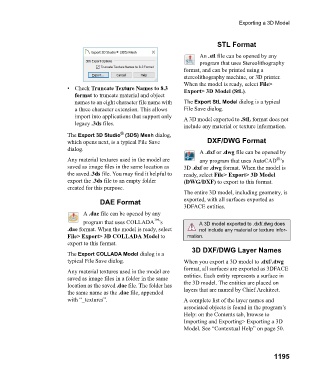Page 1196 - Chief Architect Reference Manual
P. 1196
Exporting a 3D Model
STL Format
An .stl file can be opened by any
program that uses Stereolithography
format, and can be printed using a
stereolithography machine, or 3D printer.
When the model is ready, select File>
• Check Truncate Texture Names to 8.3 Export> 3D Model (StL).
format to truncate material and object
names to an eight character file name with The Export StL Model dialog is a typical
a three character extension. This allows File Save dialog.
import into applications that support only A 3D model exported to .StL format does not
legacy .3ds files.
include any material or texture information.
®
The Export 3D Studio (3DS) Mesh dialog,
which opens next, is a typical File Save DXF/DWG Format
dialog.
A .dxf or .dwg file can be opened by
®
Any material textures used in the model are any program that uses AutoCAD ’s
saved as image files in the same location as 3D .dxf or .dwg format. When the model is
the saved .3ds file. You may find it helpful to ready, select File> Export> 3D Model
export the .3ds file to an empty folder (DWG/DXF) to export to this format.
created for this purpose.
The entire 3D model, including geometry, is
DAE Format exported, with all surfaces exported as
3DFACE entities.
A .dae file can be opened by any
™
program that uses COLLADA ’s A 3D model exported to .dxf/.dwg does
.dae format. When the model is ready, select not include any material or texture infor-
File> Export> 3D COLLADA Model to mation.
export to this format.
3D DXF/DWG Layer Names
The Export COLLADA Model dialog is a
typical File Save dialog. When you export a 3D model to .dxf/.dwg
format, all surfaces are exported as 3DFACE
Any material textures used in the model are
saved as image files in a folder in the same entities. Each entity represents a surface in
location as the saved .dae file. The folder has the 3D model. The entities are placed on
the same name as the .dae file, appended layers that are named by Chief Architect.
with “_textures”. A complete list of the layer names and
associated objects is found in the program’s
Help: on the Contents tab, browse to
Importing and Exporting> Exporting a 3D
Model. See “Contextual Help” on page 50.
1195

